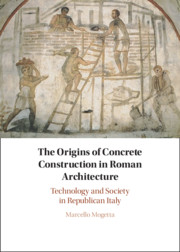 The Origins of Concrete Construction in Roman Architecture
The Origins of Concrete Construction in Roman Architecture Book contents
- The Origins of Concrete Construction in Roman Architecture
- The Origins of Concrete Construction in Roman Architecture
- Copyright page
- Contents
- Plates
- Figures
- Tables
- Acknowledgments
- One Introduction
- Two Deconstructing Roman Concrete
- Three A New Date for Concrete in Rome
- Four A View from the Suburbium
- Five Building Samnite Pompeii
- Six Colonial Networks
- Seven Conclusion
- Appendix Catalog of Sites
- Glossary
- Bibliography and Abbreviations
- Index
- Plate Section (PDF Only)
Two - Deconstructing Roman Concrete
Published online by Cambridge University Press: 15 June 2021
- The Origins of Concrete Construction in Roman Architecture
- The Origins of Concrete Construction in Roman Architecture
- Copyright page
- Contents
- Plates
- Figures
- Tables
- Acknowledgments
- One Introduction
- Two Deconstructing Roman Concrete
- Three A New Date for Concrete in Rome
- Four A View from the Suburbium
- Five Building Samnite Pompeii
- Six Colonial Networks
- Seven Conclusion
- Appendix Catalog of Sites
- Glossary
- Bibliography and Abbreviations
- Index
- Plate Section (PDF Only)
Summary
After providing a retrospective view on how concrete construction has come to be interpreted as a marker of Romanitas (i.e., Roman identity and self-image) in both specialist and popular discourse, the chapter looks more closely to ancient literary representations of the technology in order to explore how building techniques could become caught up in political debates about elite self-presentation. Bringing the relationship between patrons and builders to the fore, the discussion concentrates on processes of identity construction in the domestic sphere, as reflected in the writings of Cato and Vitruvius, and explore their relation to public architecture.
- Type
- Chapter
- Information
- The Origins of Concrete Construction in Roman ArchitectureTechnology and Society in Republican Italy, pp. 25 - 45Publisher: Cambridge University PressPrint publication year: 2021
